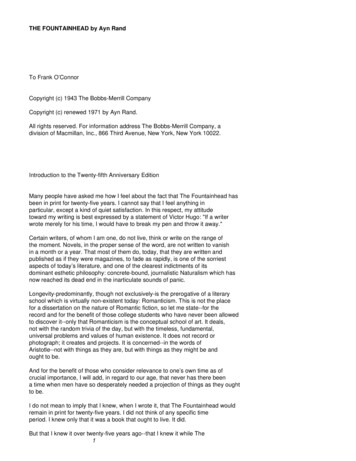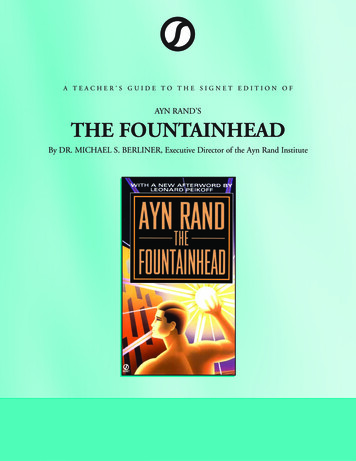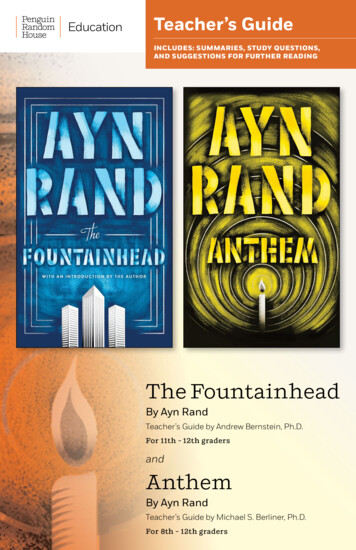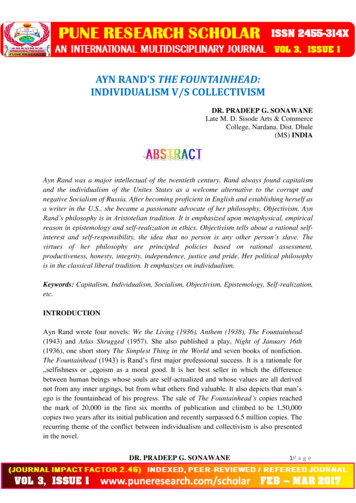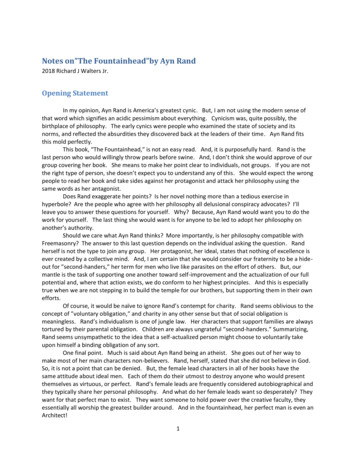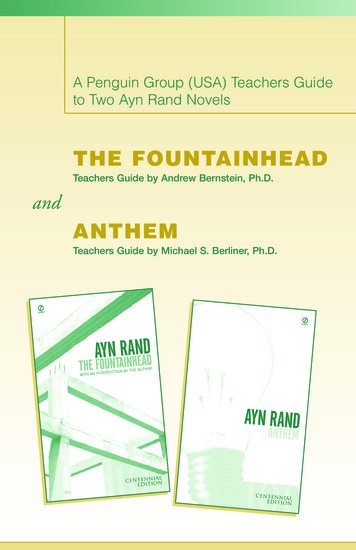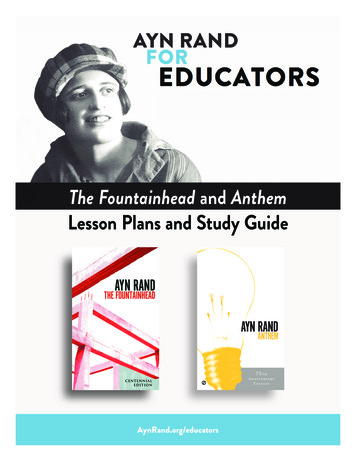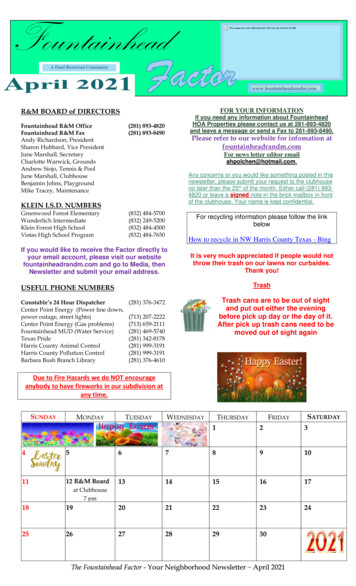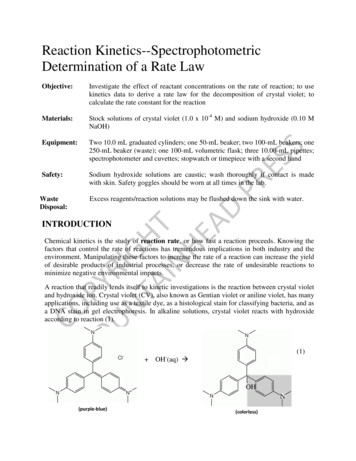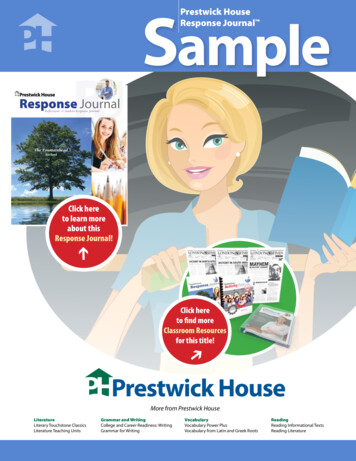
Transcription
SamplePrestwick HouseResponse Journal Response JournalReflections: A Student Response JournalThe Fountainhead Ayn RandClick hereto learn moreabout thisResponse Journal! Click hereto find moreClassroom Resourcesfor this title!More from Prestwick HouseLiteratureLiterary Touchstone ClassicsLiterature Teaching UnitsGrammar and WritingCollege and Career Readiness: WritingGrammar for WritingVocabularyVocabulary Power PlusVocabulary from Latin and Greek RootsReadingReading Informational TextsReading Literature
Response JournalReflections: A Student Response JournalThe FountainheadAyn RandP.O. Box 658, Clayton, DE 19938www.prestwickhouse.com800.932.4593Copyright 2007 by Prestwick House, Inc., P.O. Box 658, Clayton, DE 19938.1-800-932-4593. www.prestwickhouse.com Permission to copy this unit forclassroom use is extended to purchaser for his or her personal use. This material, inwhole or part, may not be copied for resale.ISBN 978-1-60389-550-7Item No. 302908
The FountainheadTo The StudentAlthough we may read a novel, play, or work of non-fiction for enjoyment,each time we read one, we are building and practicing important basic readingskills. In our ever-more complex society, in which reading has become moreand more crucial for success, this, in itself, is an important reason to spend timereading for enjoyment.Some readers, however, are able to go beyond basic reading techniques andare able to practice higher thinking skills by reflecting on what they have readand how what they read affects them. It is this act of reflection–that is, stopping to think about what you are reading–that this journal is attempting toencourage.To aid you, we have included writing prompts for each section; however, ifyou find something that you wish to respond to in the book more compellingthan our prompts, you should write about that. We hope you enjoy readingthis book and that the act of responding to what you have read increases thisenjoyment.After you read the indicated sections, choose the questions to which youwill respond. Keep in mind that there are no right or wrong answers to theseprompts, and there is no one direction in which you must go.3 Copyright 2007, Prestwick House, Inc.
The FountainheadBackground/Pre-Reading1.Ayn Rand began her screenwriting career during college and continued itwhen she emigrated to the United States. She enjoyed the writing process,but came to see it more as a tool for expressing the views of objectivismrather than for creating and adapting stories for their own sake. It is ironicthat someone who scorned the ideas of teamwork would choose a profession that requires so much collaboration with others.Rand uses her main characters to serve as mouthpieces for her philosophy.Imagine that you are a screenwriter. You have written a script that concerns one of the main values of mainstream society: education, politics,religion, the justice system, the family unit, or a different value, one ofyour own choosing.Write an opening monologue for your main character, and express youropinion about the value you have chosen in that monologue.2.The Fountainhead is a dystopian novel about an architect who never findsfinancial success despite his ingenious gift. He takes personal satisfactionfrom his immense creative gifts and from seeing his creative visions cometo life; he does not need validation from others to feel like he has talentand genius.Consider other stories you have read, or movies you have seen, that areabout people who have tremendous talents and gifts, but are unable toexperience prosperity from their gift because of their own personal stubbornness, or a refusal to satisfy society’s expectations.Come up with a character description and plot outline for your ownoriginal story about someone with tremendous gifts who is not able toexperience success for reasons similar to Howard Roark. Your plot outlineshould be written in bullet points and be no longer than a page. Copyright 2007, Prestwick House, Inc.6
The Fountainhead5.Society’s fear of genius is the primary source of opposition to HowardRoark in The Fountainhead. This opposition is the source of much conflict, and it is this conflict that moves the plot along. While such figuresas Ellsworth Toohey will embody this fear, it is the fear that is Roark’senemy, rather than a specific person. The most difficult part of the story,from Rand’s perspective, is that the antagonist is invisible and eternal.In your own life, what invisible antagonists do you face? What are thepressures that you face from day to day? Examples might be time constraints, peer pressure, body weight, procrastination, bad habits, fear offailure, or family strife, among others.If you could face one of your invisible antagonists, what would you say?Write a conversation that the two of you might have. Copyright 2007, Prestwick House, Inc.8
The Fountainhead25. At the end of Part I, the reader has a solid understanding of the differencesbetween Peter Keating and Howard Roark. While Keating has a greaterlevel of professional success, and has the greater level of recognition insociety as a great architect, he lacks personal satisfaction, because hisentire focus has been on pleasing others rather than himself.In contrast, Howard Roark designs only the buildings he wants to design,for the commissions he wants to accept. This costs him a lot of money andprestige, but he is willing to accept those costs as part of ensuring his ownpersonal happiness.Are you more like Peter Keating or Howard Roark? Based on the majordecisions you have made so far in your life, which of these two men areyou more likely to turn out like in your adult life? Why? Copyright 2007, Prestwick House, Inc.16
The Fountainhead37. In Chapter 11, Roark designs the Stoddard temple to be horizontal, andon the same scale as the height of a human. His purpose here is to makethe visitor feel strong, rather than to intimidate the visitor by sheer scale,as many religious buildings did before the modern era.In your place of worship, what is the scale? Do you worship in a building that could seat thousands and has a multistory ceiling, or is the spacesmall and intimate? How does it make you feel to worship in that environment? Write a note to a friend inviting him or her to services at thechurch, mosque, or synagogue you attend. If, however, you do not goto a public place for religious reasons, or you do not believe in religion,explain why, as if you had received the invitation.38. Stoddard’s response to Howard Roark’s temple design shows his absolutedistaste for the way things turn out. He cancels the opening and suesRoark for architectural malpractice, as well as breaking their contract.When the lawsuit goes to trial, a good number of well-known New Yorkarchitects take the stand against Roark, and the only defense that Roarkoffers is ten photographs of the temple itself.Pretend that you are a writer for an independent newspaper or magazine,and you are covering the trial for your publication. Write an article summarizing the trial from an objective perspective—in other words, you arenot putting Rand’s spin on events, nor are you putting Stoddard’s (or theother architects’) spin on events.39. After the lawsuit is over, the Stoddard Temple is redesigned and changedinto the Stoddard Home for Subnormal Children. One night, Roark goesto see the newly designed building and the ways in which its originaldesign and intentions have been radically overhauled.Imagine that you are the obituary writer for the Banner. Write an obituaryfor the original Stoddard Temple, as though the building were actually aperson. You may choose whether to slant your writing in favor of Roark,or in favor of those who think the same way as Ellsworth Toohey.21 Copyright 2007, Prestwick House, Inc.
The Fountainhead is a dystopian novel about an architect who never finds financial success despite his ingenious gift. He takes personal satisfaction from his immense creative gifts and from seeing his creative visions come to life; he does not need validation from others to feel like he has talent and genius. Consider other stories you have read, or movies you have seen, that are about people .
